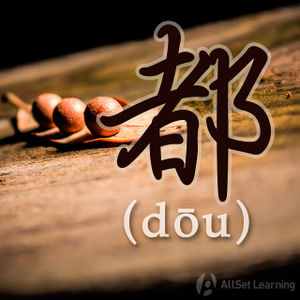Difference between revisions of "Indicating the whole with "quan""
m (Text replacement - "shóu" to "shú") |
|||
| Line 68: | Line 68: | ||
*这个 周末 我们 <em>全</em> <em>都</em> 不 在 家 。<span class="pinyin">Zhège zhōumò wǒmen <em>quán</em> <em>dōu</em> bú zài jiā.</span><span class="trans">None of us will be home this weekend.</span> | *这个 周末 我们 <em>全</em> <em>都</em> 不 在 家 。<span class="pinyin">Zhège zhōumò wǒmen <em>quán</em> <em>dōu</em> bú zài jiā.</span><span class="trans">None of us will be home this weekend.</span> | ||
*你们 <em>全</em> <em>都</em> 不 怕 吗 ?<span class="pinyin">Nǐmen <em>quán</em> <em>dōu</em> bú pà ma?</span><span class="trans">Are none of you afraid?</span> | *你们 <em>全</em> <em>都</em> 不 怕 吗 ?<span class="pinyin">Nǐmen <em>quán</em> <em>dōu</em> bú pà ma?</span><span class="trans">Are none of you afraid?</span> | ||
| − | *这些 菜 <em>全</em> <em>都</em> 没 熟 。<span class="pinyin">Zhèxiē cài <em>quán</em> <em>dōu</em> méi | + | *这些 菜 <em>全</em> <em>都</em> 没 熟 。<span class="pinyin">Zhèxiē cài <em>quán</em> <em>dōu</em> méi shú.</span><span class="trans">None of these dishes is fully cooked.</span> |
*他 的 话 我 <em>全</em> <em>都</em> 不 相信 。<span class="pinyin">Tā de huà wǒ <em>quán</em> <em>dōu</em> bù xiāngxìn.</span><span class="trans">I don't believe anything he says.</span> | *他 的 话 我 <em>全</em> <em>都</em> 不 相信 。<span class="pinyin">Tā de huà wǒ <em>quán</em> <em>dōu</em> bù xiāngxìn.</span><span class="trans">I don't believe anything he says.</span> | ||
Revision as of 06:10, 29 November 2018
-
Level
-
Similar to
-
Used for
-
Keywords
One of the uses of 全 (quán) is to indicate the entirety of something. It could be used for something like a whole household, an entire country, the whole world, etc.
Used before Noun
Structure
Simply put 全 in front of the noun you want to emphasize "the whole" of. You cannot use it with 的. Pay attention to the types of nouns you can use with 全, since it is usually paired up with 身 (body), 家 (family), 国 (country), 世界 (world), 天 (day) and the like.
全 + Noun + 都 + Predicate
The predicate part of the pattern can be a verb or an adjective.
Examples
- 我们 全 家 都 去 过 北京 。Our entire family has been to Beijing.
- 全 公司 的 人 都 不 喜欢 新 老板 。The whole company doesn't like the new boss.
- 运动 完 以后 我 全 身 都 是 汗 。My whole body was sweaty after I finished exercising.
- 全 校 都 放假 了 。The whole school is on break.
- 这个 地方 全 年 都 很 热 。This place is hot all year round.
Used before Predicate
Affirmative Form
Before a verb 全 can be omitted, but if it is used, the purpose is to emphasize the idea of "all" or "entire."
Structure
Subj. + 全都 + Predicate
Examples
- 大家 全 都 到 了。Everybody has arrived.
- 奶奶 的 头发 全 都 白 了。All of grandma's hair has turned white.
- 我 妈妈 做 的 菜 全 都 好吃 。All of the food that my mother makes is tasty.
- 作业 全 都 做 完 了 吗 ?Have you finished all your homework?
- 你 全 都 拿 走 吧。Take them all.
Negative Form: Total Negation
Structure
When you negate 全都 with 不 or 没 after it, you're not just saying "not entirely," you're saying "none of it" or "not at all."
Subj. + 全都 + 不 / 没 + Predicate
Examples
- 他们 全 都 没 去 。None of them went.
- 这个 周末 我们 全 都 不 在 家 。None of us will be home this weekend.
- 你们 全 都 不 怕 吗 ?Are none of you afraid?
- 这些 菜 全 都 没 熟 。None of these dishes is fully cooked.
- 他 的 话 我 全 都 不 相信 。I don't believe anything he says.
Negative Pattern: Partial Negation
Structure
When you negate by putting 不 or 没 before 全都, you're only partially negating. In other words, you're communicating "not all."
Subj. + 不 / 没 + 全都 + Predicate
Examples
- 他 说 得 有 道理 ,但 我 不 全 都 同意 。He has a point, but I don't agree with all of it.
- 菜 太 多 了 ,我们 没 全 都 吃完 。The food was too much. We didn't finish eating it all.
- 昨天 作业 太 多 了 ,我 没 全 都 做完 。I had too much homework yesterday. I didn't finish doing it all.
- 我 的 家人 没 全 都 来 参加 我 的 婚礼 。Not all of my family came to my wedding.
- 你 说 得 太 快 了 , 我 没 全 都 记 下来 。You spoke too fast. I didn't write down all of what you said.
See also
- Referring to "all" using "suoyou"
- Expressing "Everyone" with "shei"
- Expressing "All" with "shenme dou"
- Expressing "Every" with "mei" and "dou"
- Emphasizing quantity with "dou"
Sources and further reading
Books
- 现代汉语八百词 (pp. 457) 卓越汉语-公司实战篇 →buy



